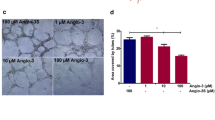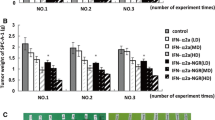Abstract
Angiogenesis has been considered an important target for cancer therapy. The inhibition of angiogenesis represents a promising strategy for anti-cancer treatment, tumor growth inhibition, and metastasis. Vasostatin 30 (Vs30), and the 14.1 kDa vasoinhibin (Vi-II-14.1) are two peptides with remarkable anti-tumor and anti-angiogenic effect. The aim of this study was to produce a novel fusion protein between Vs30 and Vi-II-14.1, denominated VS_VI, to obtain a new protein with higher biological activity. The protein fusion genes were cloned into a T7 promoter-based vector, expressed in Escherichia coli BL21-SI and purified by affinity column chromatography. In vitro assays showed that the recombinant fusion protein inhibited rat coronary endothelial cell proliferation at 65.5 % at 10 nM, whereas recombinant Vs30 and Vi-II-14.1 inhibited at 33 and 50.5 % respectively, at the same concentration. The results showed that VS_VI is significantly more active than the Vs30 and Vi-II-14.1 separately. In addition, a practical classification of the vasoinhibins based on the peptide origin and theoretical molecular weight is proposed. This is the first study to produce a new fusion protein derived from Vs30 and Vi-II-14.1, both of them proposed as promising therapeutic agents.





Similar content being viewed by others
References
Persano, L., Crescenzi, M., & Indraccolo, S. (2007). Anti-angiogenic gene therapy of cancer: Current status and future prospects. Molecular Aspects of Medicine, 28(1), 87–114. doi:10.1016/j.mam.2006.12.005.
Ribatti, D. (2009). Endogenous inhibitors of angiogenesis: A historical review. Leukemia Research, 33(5), 638–644. doi:10.1016/j.leukres.2008.11.019.
Ma, W. W., & Adjei, A. A. (2009). Novel agents on the horizon for cancer therapy. CA: A Cancer Journal for Clinicians, 59(2), 111–137.
Struman, I., Bentzien, F., Lee, H., Mainfroid, V., D’Angelo, G., Goffin, V., et al. (1999). Opposing actions of intact and N-terminal fragments of the human prolactin/growth hormone family members on angiogenesis: An efficient mechanism for the regulation of angiogenesis. Proceedings of the National Academy of Sciences of the United States of America, 96(4), 1246–1251.
Corbacho, A. M., Martinez De La Escalera, G., & Clapp, C. (2002). Roles of prolactin and related members of the prolactin/growth hormone/placental lactogen family in angiogenesis. Journal of Endocrinology, 173(2), 219–238.
Clapp, C., Torner, L., Gutierrez-Ospina, G., Alcantara, E., Lopez-Gomez, F. J., Nagano, M., et al. (1994). The prolactin gene is expressed in the hypothalamic-neurohypophyseal system and the protein is processed into a 14-kDa fragment with activity like 16-kDa prolactin. Proceedings of the National Academy of Sciences of the United States of America, 91(22), 10384–10388.
Macotela, Y., Aguilar, M. B., Guzman-Morales, J., Rivera, J. C., Zermeno, C., Lopez-Barrera, F., et al. (2006). Matrix metalloproteases from chondrocytes generate an antiangiogenic 16 kDa prolactin. Journal of Cell Science, 119(Pt 9), 1790–1800.
Clapp, C., Martial, J. A., Guzman, R. C., Rentier-Delure, F., & Weiner, R. I. (1993). The 16-kilodalton N-terminal fragment of human prolactin is a potent inhibitor of angiogenesis. Endocrinology, 133(3), 1292–1299.
Gonzalez, C., Corbacho, A. M., Eiserich, J. P., Garcia, C., Lopez-Barrera, F., Morales-Tlalpan, V., et al. (2004). 16K-prolactin inhibits activation of endothelial nitric oxide synthase, intracellular calcium mobilization, and endothelium-dependent vasorelaxation. Endocrinology, 145(12), 5714–5722.
Tabruyn, S. P., Sorlet, C. M., Rentier-Delrue, F., Bours, V., Weiner, R. I., Martial, J. A., et al. (2003). The antiangiogenic factor 16K human prolactin induces caspase-dependent apoptosis by a mechanism that requires activation of nuclear factor-kappaB. Molecular Endocrinology, 17(9), 1815–1823.
Martini, J. F., Piot, C., Humeau, L. M., Struman, I., Martial, J. A., & Weiner, R. I. (2000). The antiangiogenic factor 16K PRL induces programmed cell death in endothelial cells by caspase activation. Molecular Endocrinology, 14(10), 1536–1549.
Tabruyn, S. P., Nguyen, N. Q., Cornet, A. M., Martial, J. A., & Struman, I. (2005). The antiangiogenic factor, 16-kDa human prolactin, induces endothelial cell cycle arrest by acting at both the G0–G1 and the G2–M phases. Molecular Endocrinology, 19(7), 1932–1942. doi:10.1210/me.2004-0515.
D’Angelo, G., Martini, J. F., Iiri, T., Fantl, W. J., Martial, J., & Weiner, R. I. (1999). 16K human prolactin inhibits vascular endothelial growth factor-induced activation of Ras in capillary endothelial cells. Molecular Endocrinology, 13(5), 692–704.
Clapp, C., & Weiner, R. I. (1992). A specific, high affinity, saturable binding site for the 16-kilodalton fragment of prolactin on capillary endothelial cells. Endocrinology, 130(3), 1380–1386.
Thebault, S., Gonzalez, C., Garcia, C., Zamarripa, D. A., Nava, G., Vaca, L., et al. (2011). Vasoinhibins prevent bradykinin-stimulated endothelial cell proliferation by inactivating eNOS via reduction of both intracellular Ca2+ levels and eNOS phosphorylation at Ser1179. Pharmaceuticals, 4, 1052–1069. doi:10.3390/ph4071052.
Pike, S. E., Yao, L., Jones, K. D., Cherney, B., Appella, E., Sakaguchi, K., et al. (1998). Vasostatin, a calreticulin fragment, inhibits angiogenesis and suppresses tumor growth. Journal of Experimental Medicine, 188(12), 2349–2356.
Pike, S. E., Yao, L., Setsuda, J., Jones, K. D., Cherney, B., Appella, E., et al. (1999). Calreticulin and calreticulin fragments are endothelial cell inhibitors that suppress tumor growth. Blood, 94(7), 2461–2468.
Yao, L., Pike, S. E., & Tosato, G. (2002). Laminin binding to the calreticulin fragment vasostatin regulates endothelial cell function. Journal of Leukocyte Biology, 71(1), 47–53.
Lange-Asschenfeldt, B., Velasco, P., Streit, M., Hawighorst, T., Pike, S. E., Tosato, G., et al. (2001). The angiogenesis inhibitor vasostatin does not impair wound healing at tumor-inhibiting doses. Journal of Investigative Dermatology, 117(5), 1036–1041.
Li, X., Jiang, L., Wang, Y., Xiao, Y., Huang, Y., Yao, Q., et al. (2007). Inhibition of angiogenesis by a novel small peptide consisting of the active fragments of platelet factor-4 and vasostatin. Cancer Letters, 256(1), 29–32.
Sun, Q., Xu, Q., Dong, X., Cao, L., Huang, X., Hu, Q., et al. (2008). A hybrid protein comprising ATF domain of pro-UK and VAS, an angiogenesis inhibitor, is a potent candidate for targeted cancer therapy. International Journal of Cancer, 123(4), 942–950.
Nakamura, Y., Gojobori, T., & Ikemura, T. (2000). Codon usage tabulated from international DNA sequence databases: Status for the year 2000. Nucleic Acids Research, 28(1), 292.
Rosales-Colunga, L. M., Razo-Flores, E., Ordonez, L. G., Alatriste-Mondragon, F., & De Leon-Rodriguez, A. (2010). Hydrogen production by Escherichia coli Delta hycA Delta lacI using cheese whey as substrate. International Journal of Hydrogen Energy, 35(2), 491–499. doi:10.1016/j.ijhydene.2009.10.097.
Balderas Hernandez, V. E., Paz Maldonado, L. M., Medina Rivero, E., Barba de la Rosa, A. P., Jimenez-Bremont, J. F., Ordonez Acevedo, L. G., et al. (2008). Periplasmic expression and recovery of human interferon gamma in Escherichia coli. Protein Expression and Purification, 59(1), 169–174. doi:10.1016/j.pep.2008.01.019.
Marino-Marmolejo, E. N., De Leon-Rodriguez, A., de la Rosa, A. P., & Santos, L. (2009). Heterologous expression and characterization of an alcohol dehydrogenase from the archeon Thermoplasma acidophilum. Molecular Biotechnology, 42(1), 61–67. doi:10.1007/s12033-008-9130-z.
Sierra-Ramirez, A., Morato, T., Campos, R., Rubio, I., Calzada, C., Mendez, E., et al. (2004). Acute effects of testosterone on intracellular Ca2+ kinetics in rat coronary endothelial cells are exerted via aromatization to estrogens. American Journal of Physiology Heart and Circulatory Physiology, 287(1), H63–H71.
Mosmann, T. (1983). Rapid colorimetric assay for cellular growth and survival: Application to proliferation and cytotoxicity assays. Journal of Immunological Methods, 65(1–2), 55–63.
Piwnica, D., Touraine, P., Struman, I., Tabruyn, S., Bolbach, G., Clapp, C., et al. (2004). Cathepsin D processes human prolactin into multiple 16K-like N-terminal fragments: study of their antiangiogenic properties and physiological relevance. Molecular Endocrinology, 18(10), 2522–2542.
Khurana, S., Liby, K., Buckley, A. R., & Ben-Jonathan, N. (1999). Proteolysis of human prolactin: Resistance to cathepsin D and formation of a nonangiostatic, C-terminal 16K fragment by thrombin. Endocrinology, 140(9), 4127–4132.
Galfione, M., Luo, W., Kim, J., Hawke, D., Kobayashi, R., Clapp, C., et al. (2003). Expression and purification of the angiogenesis inhibitor 16-kDa prolactin fragment from insect cells. Protein Expression and Purification, 28(2), 252–258.
Sun, Q. M., Chen, L. L., Cao, L., Fang, L., Chen, C., & Hua, Z. C. (2005). An improved strategy for high-level production of human vasostatin120-180. Biotechnology Progress, 21(4), 1048–1052.
Maldonado, L. M., Hernandez, V. E., Rivero, E. M., Barba de la Rosa, A. P., Flores, J. L., Acevedo, L. G., et al. (2007). Optimization of culture conditions for a synthetic gene expression in Escherichia coli using response surface methodology: The case of human interferon beta. Biomolecular Engineering, 24(2), 217–222.
Zhang, L., Li, H. Y., Li, H., Zhao, J., Su, L., Zhang, Y., et al. (2011). Lipopolysaccharide activated phosphatidylcholine-specific phospholipase C and induced IL-8 and MCP-1 production in vascular endothelial cells. Journal of Cellular Physiology, 226(6), 1694–1701.
Li, A., Varney, M. L., Valasek, J., Godfrey, M., Dave, B. J., & Singh, R. K. (2005). Autocrine role of interleukin-8 in induction of endothelial cell proliferation, survival, migration and MMP-2 production and angiogenesis. Angiogenesis, 8(1), 63–71. doi:10.1007/s10456-005-5208-4.
Nguyen, N. Q., Tabruyn, S. P., Lins, L., Lion, M., Cornet, A. M., Lair, F., et al. (2006). Prolactin/growth hormone-derived antiangiogenic peptides highlight a potential role of tilted peptides in angiogenesis. Proceedings of the National Academy of Sciences of the United States of America, 103(39), 14319–14324. doi:10.1073/pnas.0606638103.
Lopez-Gomez, F. J., Torner, L., Mejia, S., de la Escalera, G. M., & Clapp, C. (1995). Immunoreactive prolactins of the neurohypophyseal system display actions characteristic of prolactin and 16K prolactin. Endocrine, 3(8), 573–578. doi:10.1007/BF02953021.
Belloni, D., Scabini, S., Foglieni, C., Veschini, L., Giazzon, A., Colombo, B., et al. (2007). The vasostatin-I fragment of chromogranin A inhibits VEGF-induced endothelial cell proliferation and migration. FASEB Journal, 21(12), 3052–3062. doi:10.1096/fj.06-6829com.
Russell, J., Schneider, A. B., Katzhendler, J., Kowalski, K., & Sherwood, L. M. (1979). Modification of human placental lactogen with plasmin. Preparation and characterization of a modified hormone with increased biologic activity. Journal of Biological Chemistry, 254(7), 2296–2301.
Ge, G., Fernandez, C. A., Moses, M. A., & Greenspan, D. S. (2007). Bone morphogenetic protein 1 processes prolactin to a 17-kDa antiangiogenic factor. Proceedings of the National Academy of Sciences of the United States of America, 104(24), 10010–10015. doi:10.1073/pnas.0704179104.
Li, C. H. (1982). Human growth hormone: 1974–1981. Molecular and Cellular Biochemistry, 46(1), 31–41.
Spolaore, B., Polverino de Laureto, P., Zambonin, M., & Fontana, A. (2004). Limited proteolysis of human growth hormone at low pH: Isolation, characterization, and complementation of the two biologically relevant fragments 1–44 and 45–191. Biochemistry, 43(21), 6576–6586. doi:10.1021/bi049491g.
Acknowledgments
We thank Dr. Carmen Clapp and Dr. Gabriel Nava from the Instituto de Neurobiología, UNAM for the pSG-hPRL plasmid, and Héctor Rosas Hernández (UASLP) and Leandro G. Ordóñez Acevedo (IPICyT) for technical assistance. G. Vazquez thanks CONACyT for her scholarship No. 211450. We thank Jennifer Eckerly Goss for the English revision. The sponsors had no role in study design, in the collection, analysis, and interpretation of data, in writing the report or in the decision to submit the paper for publication.
Disclosure
This work was supported partially by CONACyT-BASICAS 82010 and PROMEP/103.5/072574.
Author information
Authors and Affiliations
Corresponding author
Rights and permissions
About this article
Cite this article
Vazquez Rodriguez, G., Gonzalez, C. & De Leon Rodriguez, A. Novel Fusion Protein Derived from Vasostatin 30 and Vasoinhibin II-14.1 Potently Inhibits Coronary Endothelial Cell Proliferation. Mol Biotechnol 54, 920–929 (2013). https://doi.org/10.1007/s12033-012-9642-4
Published:
Issue Date:
DOI: https://doi.org/10.1007/s12033-012-9642-4




